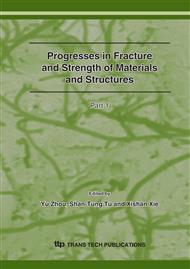p.158
p.162
p.166
p.170
p.174
p.178
p.182
p.186
p.190
Influence of Testing Frequency on Fatigue Crack Growth of 6061-T6 Aluminum Alloy in Hydrogen Gas Environment
Abstract:
In order to investigate the effects of testing frequency on the fatigue crack growth rate of 6061-T6 aluminum alloy in hydrogen gas environment, fatigue crack growth tests were carried out on specimens with small artificial holes in 0.18 MPa hydrogen gas or in 0.18 MPa nitrogen gas. It takes long time to test at low testing frequency, so in this study an accelerated test method was proposed and fatigue tests were carried out using this method. The fatigue crack growth rate in hydrogen gas environment accelerates compared with in nitrogen gas environment. The crack growth rate at lower testing frequency tends to higher.
Info:
Periodical:
Pages:
174-177
Citation:
Online since:
September 2007
Authors:
Price:
Сopyright:
© 2007 Trans Tech Publications Ltd. All Rights Reserved
Share:
Citation:


